Arthropods Week 2
1/66
Earn XP
Description and Tags
<3
Name | Mastery | Learn | Test | Matching | Spaced |
|---|
No study sessions yet.
67 Terms
Autapomorphy Insects
Body consisting out of head, thorax and abdomen
Four principal mouthpart types
Biting-chewing
Piering-sucking
Siphoning (like straw, Lepidoptera)
Sponging (Diptera that do not sting; flies)
6 major wing veins
Costa
Subcosta
Radius
Media
Cubitus
Analis
Protura apomorphies
No antennae, using front legs for probing substrate
Blind
Collembola apomorphies
Only 6 abdominal segments
Retinaculum and furca for jumping
Ventral tube for multiple purposes (e.g. used for cleaning and taking up H2O from air)
4 groups of Collembola
Entomobryomorpha: Prothorax very small, well developed furca
Poduromorpha: Short legs, elongated body, Many without furca; Uniform colouration
Symphypleona: Body globular; Thorax and Abdomen segments seemingly fused together
Neelipleona: Tinyyyyy
Diplura apomorphies
long homonomous flagellate antennae & cerci
blind
(generally mostly based on molecular data tho??)
2 groups of Diplura
Japygoidea: Predatory, forceps
Campodeoidea: eat fungi hyphen, detritus and carrion
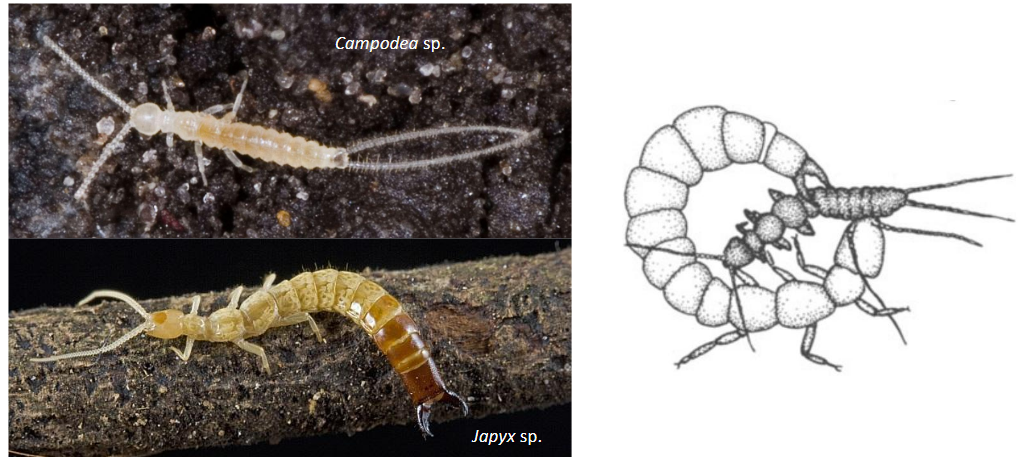
Entognathy
Mouthparts hidden within head capsule: Gena fused to labium (and labrum?) → creates a mouth cone, within mouth cone are mandibles and maxillae
Collembola mouthparts
piercing-sucking;
stylet-like mouthparts
rotation of mandibes to grind particles
Archaeognatha apomorphies
7-segmented palpus maxillaris
Zygentoma apomorphies
Presence of 4 labial muscles
Collembola + Protura synapomorphies
Not morphologically well-reasoned, mostly molecular data
Diplura + Archaeognatha + Zygentoma + Pterygota synapomorphies
long terminal filaments,
long antennae
SUCKS as argument bc there are a lot of reductions
Archaeognatha + Zygentoma + Pterygota synapomorphies
Ectognathy
(also: presence of ovipositor)
Zygentoma + Pterygota synapomorphies
Dicondyly (2 joints on mandibles)
Palaeoptera apomorphies
Form of maxillae: lacinia with well-developed teeth = Dentisetae
Very short antennae
Reduction of a muscle within the labium
Neoptera apomorphies
can fold wings flat over the abdomen, with two folding lines
Ephemeroptera apomorphies
Subimaginal stage
Imago without mouthparts
Tracheal gills on several abdominal segments
Odonata apomorphies
Flight muscles directly attached to wings
Head arrester system
Males with secondary copulatory apparatus
Nymphs with labial mask
WHY evolved head arrester system??
Head microstructures and neck microstructures connected in velcro-like manner
more stable connection of head and thorax
During flight activated to counter G-forces, otherwise head would be dislocated during rapid flight and turning maneuvers
Polyneoptera apomorphies? Which groups?
Hard to argue for monophyly from morphological point of view :/ based on molecular studies
Plecoptera (Stone flies)
Grasshoppers,
Cockroaches and alliesss
Order Blattodea (cockroaches and termites)
Order Mantodea (praying mantises)
Order Orthoptera (grasshoppers, crickets, katydids)
Order Dermaptera (earwigs)
Order Embioptera (web-spinners)
Order Plecoptera (stoneflies)
Order Grylloblattodea (ice-crawlers)
Order Mantophasmatodea (gladiators)
Order Phasmatodea (stick and leaf insects)
Order Zoraptera (angel insects)
Zoraptera apomorphies
Angel insects <3
9-segmented antennae
Dermaptera apomorphies
Forewings modified into tegmina/hemielytra
Hindwings with complicated folding structure
Cerci
Plecoptera apomorphies
Stone flies
two long multisegmented cerci (plesiomorphic lol)
Reduction of certain head muscles and abdominal muscles
Monophyly mainly based in reduction characters
Poorly reasoned based on morphology
2 lineages of Plecoptera
Antarctoperlaria
Arctoperlaria
Orthoptera
+the suborders pleasee
Jumping hindlegs with enlarged femur
Ensifera: long antennae, sword-like ovipositor
Caelifera: short antennae, no ovipositor, use whole abdomen to lay eggs into substrate
Orthoptera mouthparts
biting-chewing
orthognathous
Mantophasmatodea mouthparts
Heel walkers
orthognathous
Grylloblattodea
Ice crawlers
cold adapted (1-4°C)
Hemolymph with anti-freezing substance
no wings:/
Mouthparts Grylloblattodea
prognathous
Embioptera
footspinners
spinning apparatur: silk glands on enlarged tarsal segment on foreleg
in colonies
females wingless

Embioptera mouthparts
prognathous
Phasmatodea mouthparts
<3
Orthognathous
Mantodea apomorphies
Raptorial forelegs for catching prey
Blattodea mouthparts
Biting-chewing
"hypognathous"
Isoptera mouthparts
Chewing-biting
"hypognathous"
show same bite characteristics as some holometabolan lineages
-> might be related to wood-feeding lifestyle since ancestral holometabolan probably also wood-feeding
Mouthparts of Hemiptera
Piercing-sucking:
Maxillae fused (lock and key), enframed by mandibles
inside labial tunnel
Mouthparts Hymenoptera
Mandibles biting-chewing,
but labio-maxillary complex used for licking up food
Mouthparts Brachycera
sponging mouthparts
Mandibles reduced; Maxillae and Labium -> Labellum
Mouthparts Nematocera
piercing-sucking
Mandibles, Labrum, Hypopharynx and laciniae modified into proboscis. Labium as guiding structure;
Food goes through labrum, saliva through hypopharynx
Name the orders of Paraneoptera
Psocodea - lice
Psocoptera – book lice
Phthiraptera – biting (“true”) lice
Thysanoptera – thrips
Hemiptera – true bugs
Psocoptera apomorphies
(book lice)
Elongated freely movable laciniae
Phthiraptera: Adaptations for parasitism
Biting lice
Tarsi with single claw to cling to hair
Dorsoventrally flat
No wings/reduced wings
Thysanoptera apomorphies
thrips <3
only have one single (LEFT) mandible
wings reduced to thin bands with many hairs (“Fransen”)
Hemiptera apomorphies
Proboscis with characteristic configuration:
maxillae fused (form 2 inner lumen: for saliva and food), enframed by mandibles, surrounded by labium
2nd maxillae (=LABIUM) modified into sheath
Hemiptera suborders
Sternorrhyncha (plant bugs)
Auchenorrhyncha (cicadas)
Heteroptera (true bugs)
How can you differentiate plant bugs, cicadas and true bugs?
Point of insertion of proboscis and length of antennae:
Sternorrhyncha: Proboscis originates from “below” the head capsule, long antennae
Auchenorrhyncha: Proboscis originates from “below” the head capsule, short antennae
Heteroptera: Proboscis originates at anterior part on head capsule
What are the reasons for the strong diversification of hemipterans?
Camouflage (→ sometimes draastic morphological changes)
special life cycles, e.g. parthenogenesis, parasitism
What is a synapomorphy Hexapoda share with (other lol) crustaceans?
2 corneagenous cells in ommatidia
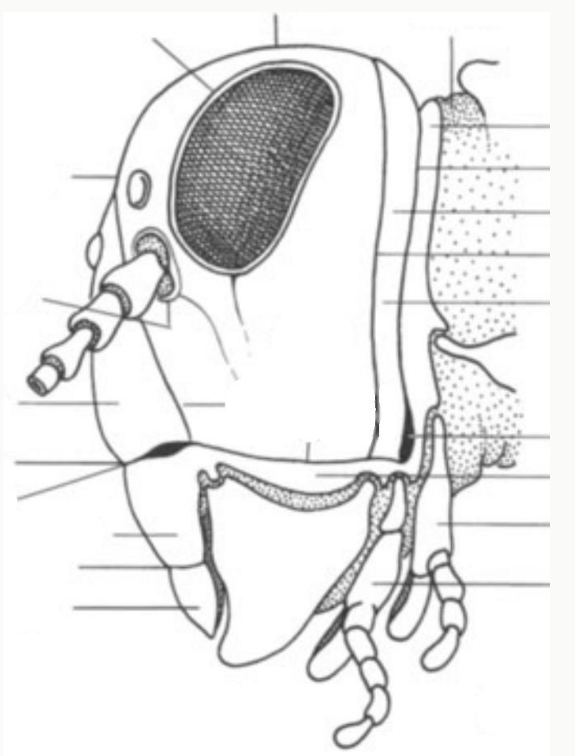
:(
:)
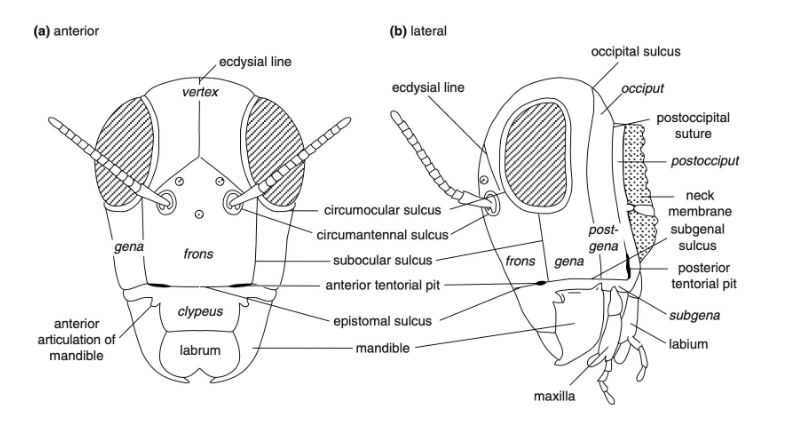
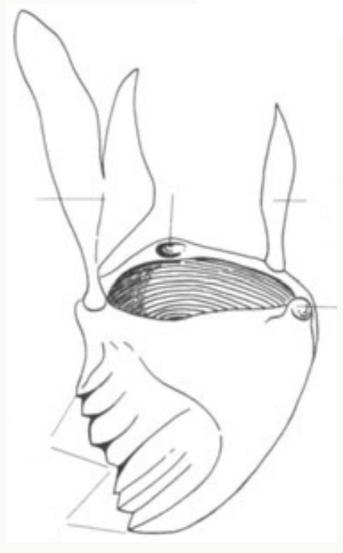
:(
:)
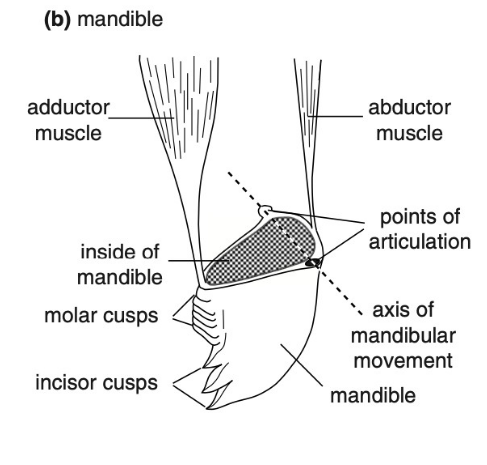
What are dicondyle mandibles?
mandibles with two ball and socket joints
Posterior: condyle
Anterior: socket
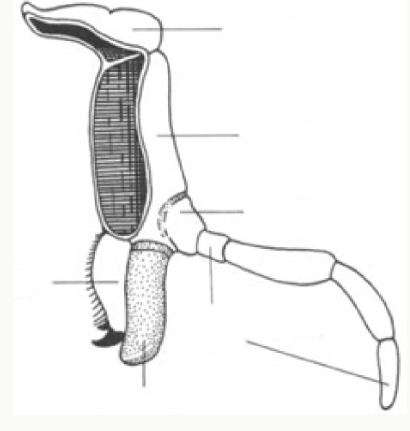
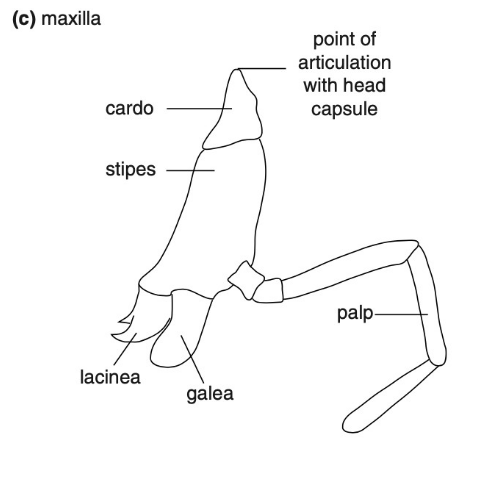
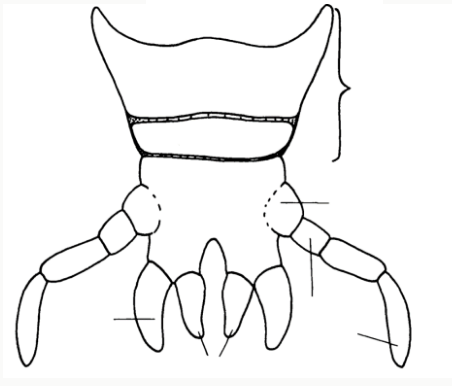
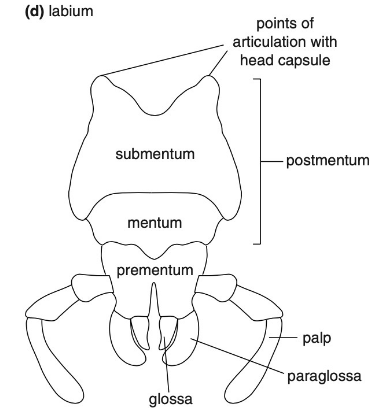
Mouthparts Lepidoptera
Basal ones (Micropterigidae) biting chewing
higher taxa: siphoning mouthparts!
coiled up proboscis (= right and reft galea fused)
Zygentoma families
Nicoletidae: often associated to ants, live in ant nests, have same smell, are not attacked therefore; FAST, short terminal filaments and relatively short antennae, shorter legs
Lepismatidae: well-developed terminal filament, very long antennae
Lepidotrichidae: basal-most branching family
flight apparatus Odonata
“indirect-direct”
Some muscles attach directly at wing base, some muscles insert indirectly, on thorax
no longitudinal muscles?
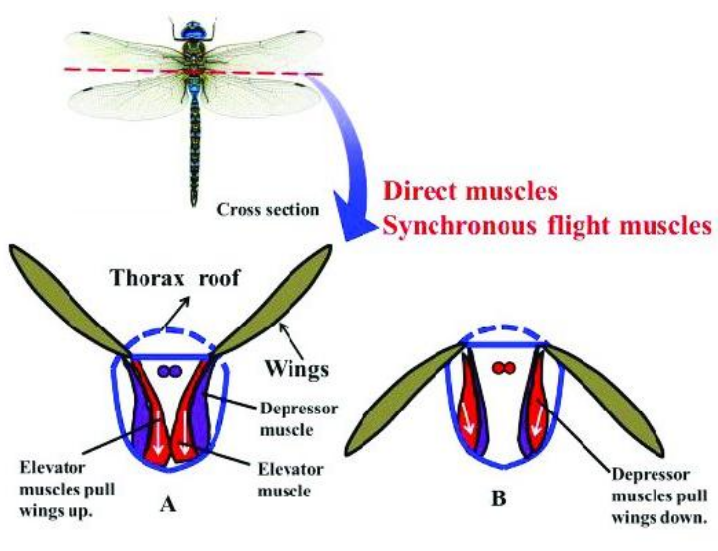
flight apparatus Neoptera + Ephemeroptera
“indirect”
Muscles attach to roof of thorax, and have longitudinal muscles going through thorax
Archaeognatha families
Machilidae, Meinertellidae
Suborders of Odonata
Zygoptera, Epiprocta (Anisoptera, Epiophlebiidae)
Collembola sperm transfer
external sperm transfer
male desposits spermatophore,
female: uptake via mouth opening/digestive tract
Archaeognatha feeding
rolling movements of mandibles → grind molar areas of mandibles against each other
(little bit like cows <3)
feed on algae, lichen, fungi
In what group did we talk about directed gliding?
Meinertellidae (→ Archaeognatha)
Paraneoptera apomorphies
1st maxillae stylet-like
→ adaptation for liquid food uptake
Thysanoptera + Hemiptera synapomorphies
Mandibles stylet-shaped
Blattodea apomorphies
Monophyly poorly argued from morphological point of view,
mainly based on molecular data